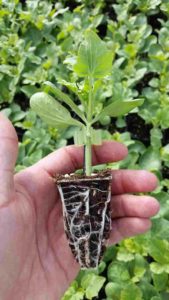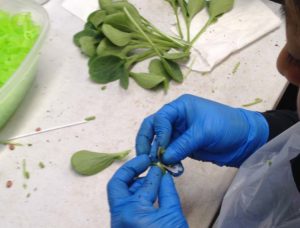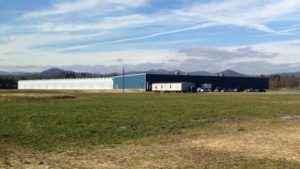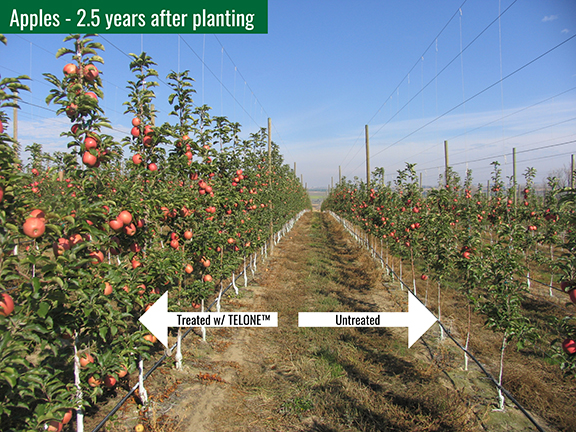Vegetable Grafting Facility Gears Up For Increased Production

One of the crops Tri-Hishtil is focusing on is watermelon, as shown here.
Photo credit: Tri-Hishtil
The Tri-Hishtil grafting company, which broke ground on its new facility in September 2015, has already made significant strides in its production of grafted vegetables.
The company is in partnership with three other entities: the North Carolina-based TriEst, which specializes in soil fumigation; the Israeli-based nursery Hishtill, which has extensive experience in grafted plant production; and finally Centro SEIA, based in Italy, which has spent more than 20 years grafting solanaceous crops.
The facility is nestled in the mountains of Mills River, NC, a location which provides abundant sunlight in the wintertime and moderate summer temperatures for optimal growing. The company is already poised to double production within the next year, according to general manager Bert Lemkes.
Crops And Distribution
TriEst is currently in charge of selling and distributing Tri-Histil’s grafted plants alongside a second distributor located on the West Coast. Crops the company is focusing on include watermelon and tomatoes.
“We shipped our first plants in January to south Florida, Arizona, California, and moved with the season to Georgia, Mississippi, Alabama, South Carolina, and North Carolina,” Lemkes says.
“We’re looking at grafted tomatoes for greenhouse production, but that’s in the early stages. There are other vegetables we’re considering including peppers, but we haven’t gotten there yet,” he explains.
The facility is capable of producing a variety of other crops thanks to the expertise of their global partners, but production of those crops largely depends on customer demand. Since opening, Tri-Hishtil has produced melons and cantaloupes, on order, with the expectation that other crops will be demanded as business progresses.
“In general we have the potential to expand our production rather quickly. The facility is built in a way that we can expand without interrupting any of the existing infrastructure, and growth will depend on the demand of our market.”
Working With The Grower
While managing the plant’s response to soil-borne diseases is a primary function of grafting, Lemkes warns that the process is not a silver bullet solution for all problems.
“It’s important to really look at the benefits [of grafting] versus the additional costs. If there are soil-borne disease issues, then grafted plants are potentially a very good solution, but it does come with a price tag,” he says.
“You want to make sure that all of the other inputs on the farm, whether it’s irrigation, fertigation, etc., are all being managed appropriately. Otherwise you won’t get the best result out of the grafted plant.”
While Lemkes notes that the use of grafted vegetables has taken off in Europe, U.S. growers have been slower to adopt the technology for price concerns as well as the need to see visible results.
For these reasons, Tri-Hishtil has made it a priority to create large enough trials in the field so growers can accurately see the benefits of grafted plants.
Furthermore, offering end-to-end consultation for the grower has enabled the company to ensure that growers are getting exactly what they need from the grafted plants.
“First we need to find out from the potential customer what their area of concern is because there are a lot of different rootstocks to choose from. Most growers know exactly what scion they want, and the combination of the scion and rootstock is key,” he explains.
“From there it’s a matter of input from our experts in Israel and Italy that have experience with the different rootstocks. We then find the right combination, and produce the plant from there.”
The Grafting Process

This worker is in the process of grafting watermelon.
Photo credit: Tri-Hishtil
Currently all of the plants at Tri-Hishtil are being grafted manually.
“Cuts are made in the rootstock with the use of a razor blade, and the scion and rootstock are combined. The plants are then [joined together] with a plastic clip and put in a special area for healing. They then go back to the greenhouse to get hardened off,” Lemkes explains.
During the peak season Tri-Hishtil has approximately 50 workers grafting plants, and ships an average of 150,000 plants per week.
There has been talk of mechanical grafting, but Lemkes says the potential for the spread of viruses and bacteria increase with the use of machines.
“When you graft, you basically are doing surgery on two plants to put them together. [Proper hygiene is critical for] this procedure, so we make sure the tools are clean so we don’t spread potential bacteria,” he says.
“However, when you start working with machines you have the same risk of spreading bacteria, but as you go from batch to batch you would have to clean the whole machine. With our way, you just have to change the razor blade and gloves.”
Future Plans

The Tri-Hishtil facility is located in North Carolina. Photo credit: Tri-Hishtil
Looking ahead, Lemkes says that there has been interest from seed breeders to use grafting to bring new varieties into the market, that may have benefits from a marketing standpoint but that may not have good resistance to soil-borne diseases.
For example, he mentions old heirloom varieties. “You can take the good genetics of the heirloom and breed that into a new variety. Because the roots may not have resistance to Fusarium wilt, you can introduce that to a new plant and get some excitement from the market,” Lemkes says.
“It has the taste, texture, and what the consumer is looking for in an heirloom, but it has a higher production potential and better disease resistance.”









